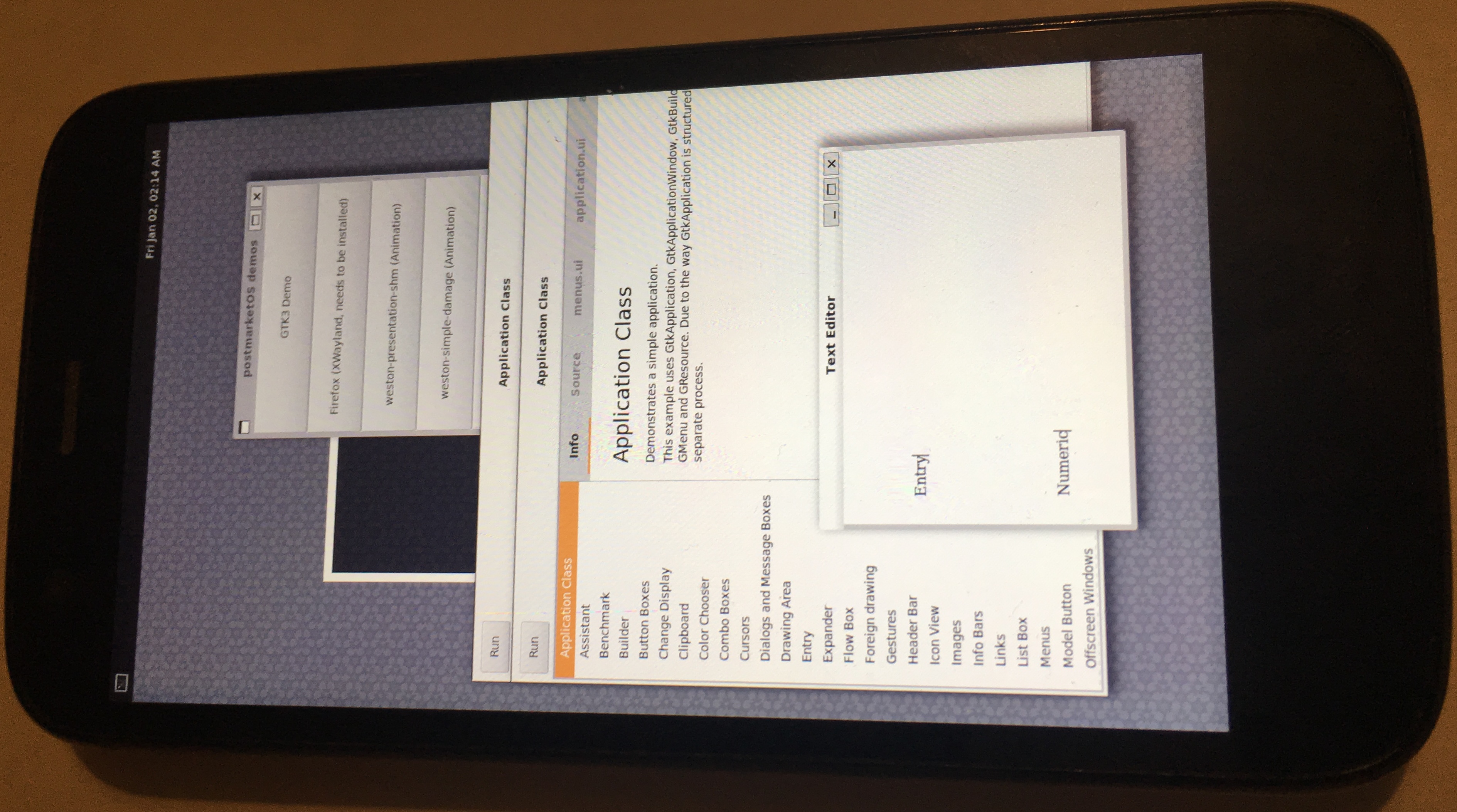PostmarketOS: Unterschied zwischen den Versionen
(+) |
(+) |
||
| Zeile 27: | Zeile 27: | ||
postmarketOS wurde erstmals im Mai 2017 auf GitLab veröffentlicht.<ref>[https://postmarketos.org/blog/2017/05/26/intro/ postmarketOS // Aiming for a 10 year life-cycle for smartphones, May 26, 2017]</ref> Im Mai 2020 bootete postmarketOS bereits auf über 200 Smartphones und Tablets.<ref>[https://tuxphones.com/postmarketos-boots-200-linux-phones-tablets-sbcs/ TuxPhones - postmarketOS now boots on over 200 phones and tablets, 6 May 2020]</ref> Das Unternehmen Pine64 lieferte Mitte 2020 die neueste Community Edition des PinePhones mit postmarketOS aus. Für die darin verwendete Hardware stehen jeweils freie Treiber zur Verfügung.<ref name="heise4847080"/> | postmarketOS wurde erstmals im Mai 2017 auf GitLab veröffentlicht.<ref>[https://postmarketos.org/blog/2017/05/26/intro/ postmarketOS // Aiming for a 10 year life-cycle for smartphones, May 26, 2017]</ref> Im Mai 2020 bootete postmarketOS bereits auf über 200 Smartphones und Tablets.<ref>[https://tuxphones.com/postmarketos-boots-200-linux-phones-tablets-sbcs/ TuxPhones - postmarketOS now boots on over 200 phones and tablets, 6 May 2020]</ref> Das Unternehmen Pine64 lieferte Mitte 2020 die neueste Community Edition des PinePhones mit postmarketOS aus. Für die darin verwendete Hardware stehen jeweils freie Treiber zur Verfügung.<ref name="heise4847080"/> | ||
postmarketOS 21.12 vom 29. Dezember 2021 basiert auf Alpine Linux 3.15 und unterstützt 23 Geräte von Smartphones über Tablets bis ARM-Notebooks: Arrow DragonBoard 410c, ASUS MeMo Pad 7, [[BQ (Unternehmen)|BQ]] Aquaris X5, Lenovo A6000 und A6010, Motorola Moto G4 Play, ODROID HC2, [[OnePlus 6]] und [[OnePlus 6T|6T]], PINE64 PineBook Pro, PinePhone, PineTab sowie RockPro64, [[Purism Librem]] 5, Samsung Galaxy A3 (2015) und A5 (2015) sowie S4 Mini Value Edition, Galaxy Tab A 8.0 und A 9.7, Wileyfox Swift, Xiaomi Mi Note 2, Pocophone F1 und Redmi 2.<ref>[https://www.heise.de/news/Mobil-Linux-postmarketOS-v21-12-unterstuetzt-mehr-Geraete-6317624.html Mobil-Linux postmarketOS v21.12 unterstützt mehr Geräte | heise online, 04.01.2022]</ref> | postmarketOS 21.12 vom 29. Dezember 2021 basiert auf Alpine Linux 3.15 und unterstützt 23 Geräte von Smartphones über Tablets bis ARM-Notebooks: Arrow DragonBoard 410c, ASUS MeMo Pad 7, [[BQ (Unternehmen)|BQ]] Aquaris X5, Lenovo A6000 und A6010, Motorola Moto G4 Play, ODROID HC2, [[OnePlus 6]] und [[OnePlus 6T|6T]], PINE64 PineBook Pro, PinePhone, PineTab sowie RockPro64, [[Purism Librem]] 5, Samsung Galaxy A3 (2015) und A5 (2015) sowie S4 Mini Value Edition, Galaxy Tab A 8.0 und A 9.7, Wileyfox Swift, Xiaomi Mi Note 2, Pocophone F1 und Redmi 2.<ref>[https://www.heise.de/news/Mobil-Linux-postmarketOS-v21-12-unterstuetzt-mehr-Geraete-6317624.html Mobil-Linux postmarketOS v21.12 unterstützt mehr Geräte | heise online, 04.01.2022]</ref> Anfang Juni 2022 gelang es erstmals, postmarketOS mit Linux-Kernel 5.18 auf einem iPad Air 2 mit Apple A8X-SoC zu booten.<ref>[https://www.heise.de/news/Linux-soll-alte-iPads-flottmachen-7155190.html Linux soll alte iPads flottmachen | heise online, 28.06.2022]</ref> | ||
== Fotos == | == Fotos == | ||
| Zeile 36: | Zeile 36: | ||
File:Plasma-mobile-hammerhead_01.jpg|KDE Plasma Mobile auf postmarketOS | File:Plasma-mobile-hammerhead_01.jpg|KDE Plasma Mobile auf postmarketOS | ||
</gallery> | </gallery> | ||
== Weblinks == | == Weblinks == | ||
*https://postmarketos.org/ | *https://postmarketos.org/ | ||
Version vom 23. Juli 2022, 09:17 Uhr
| PostmarketOS | |
|---|---|

| |
| Lizenz(en) | GNU GPL[1] |
| Erscheinungsdatum | Mai 2017 |
| Kernel | monolithisch (Linux) |
| Architektur(en) | ARM, ARM64, x86, x86-64 |
| Website | postmarketos.org |
postmarketOS (abgekürzt pmOS) ist ein freies und quelloffenes Betriebssystem für Geräte mit Touchscreen wie Smartphones. Es basiert auf die Linux-Distribution Alpine Linux und läuft auch auf mehreren herkömmlichen Smartphones bekannter Hersteller, auf denen dann proprietäre Treiber für die Nutzung einzelner Komponenten benötigt werden.[2]
Geschichte
postmarketOS wurde erstmals im Mai 2017 auf GitLab veröffentlicht.[3] Im Mai 2020 bootete postmarketOS bereits auf über 200 Smartphones und Tablets.[4] Das Unternehmen Pine64 lieferte Mitte 2020 die neueste Community Edition des PinePhones mit postmarketOS aus. Für die darin verwendete Hardware stehen jeweils freie Treiber zur Verfügung.[2]
postmarketOS 21.12 vom 29. Dezember 2021 basiert auf Alpine Linux 3.15 und unterstützt 23 Geräte von Smartphones über Tablets bis ARM-Notebooks: Arrow DragonBoard 410c, ASUS MeMo Pad 7, BQ Aquaris X5, Lenovo A6000 und A6010, Motorola Moto G4 Play, ODROID HC2, OnePlus 6 und 6T, PINE64 PineBook Pro, PinePhone, PineTab sowie RockPro64, Purism Librem 5, Samsung Galaxy A3 (2015) und A5 (2015) sowie S4 Mini Value Edition, Galaxy Tab A 8.0 und A 9.7, Wileyfox Swift, Xiaomi Mi Note 2, Pocophone F1 und Redmi 2.[5] Anfang Juni 2022 gelang es erstmals, postmarketOS mit Linux-Kernel 5.18 auf einem iPad Air 2 mit Apple A8X-SoC zu booten.[6]
Fotos
-
Nokia N9 mit Desktop Xfce auf postmarketOS
-
Motorola Moto G mit Weston Compositor auf postmarketOS
-
Google/Asus Nexus 7 mit Weston Compositor auf postmarketOS
-
KDE Plasma Mobile auf postmarketOS
Weblinks
- https://postmarketos.org/
- https://wiki.postmarketos.org/ postmarketOS Wiki
- postmarketOS bei X/Twitter

- postmarketOS bei Wikimedia Commons

- PostmarketOS in der englischsprachigen Wikipedia

Quellen
- ↑ LICENSE · master · postmarketOS / postmarketos-images · GitLab
- ↑ 2,0 2,1 PinePhone Community Edition mit Mobil-Linux postmarketOS verfügbar | heise online, 18.07.2020
- ↑ postmarketOS // Aiming for a 10 year life-cycle for smartphones, May 26, 2017
- ↑ TuxPhones - postmarketOS now boots on over 200 phones and tablets, 6 May 2020
- ↑ Mobil-Linux postmarketOS v21.12 unterstützt mehr Geräte | heise online, 04.01.2022
- ↑ Linux soll alte iPads flottmachen | heise online, 28.06.2022




